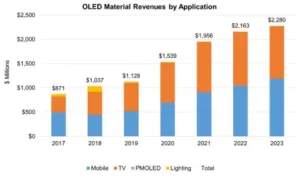In my last Display Daily I argued that the future of OLED as the TV panel technology widely accepted as the very best is severely limited. The reason: OLED is not bright enough to do a good job of rendering content that is mastered with a peak luminance of 4000 nits, and that is what Hollywood types are doing right now.

The tone mapping from the large color volume of the HDR4000 media to a much smaller color volume that the OLED-TV can actually present to the viewer is brutal, and it shows in color shifts and reduced color differences, as well as the necessarily reduced dynamic range. (In the real world, OLED dynamic range is NOT infinite.)
Nonetheless, OLED-TV sales and market penetration are projected to grow for years, and our friends at DSCC and the OLED Association have now provided some enriching data in DSCC’s latest Quarterly OLED Materials Report. The short story is that DSCC and OLED-A expect sales of OLED stack materials to grow from $1.04 billion in 2018 to $2.28 billion in 2023. As shown in the graphic, most of these sales are and will be divided between mobile and TV. You have to squint to see the small and decreasing share for lighting applications, and seeing the thin gray slice for passive-matrix OLED at this scale would require more imagination than I have. DSCC reminds us that LG Display had previously removed itself from the OLED lighting business, and Pioneer is retiring from the application this year, which contributes to the decreasing yellow sliver on the graphic from this year forward.
The meaningful applications for OLED materials are mobile devices and television. Revenues will grow from $1.04 billion in 2018 to $2.28 billion in 2023. (Graphic: DSCC and OLED-A)
Let me digress. The only surprise in major players removing themselves from the OLED lighting market is that it took them so long. Despite architects’ understandable fantasies about gently glowing walls, most OLED lighting applications have relied on small, rigid panels — a geometry that can be implemented less expensively, more efficiently, and with longer life using inorganic LEDs and edge-lit light guides. Except for architectural applications, OLED lighting was a dumb idea from the get-go. It will be good to see fewer resources wasted on it, but, as the graphic shows, it doesn’t really matter much.
As you may remember, my current choice for the premium TV technology to step into the spot above OLED is dual-cell LCD, and, specifically, the 65-inch Hisense U9E using BOE’s panel, which was shown as a very impressive prototype at the Nanosys booth at SID Display Week in May, and was promised for 2020 production. Now, in its coverage of UDE Shanghai this week, DSCC updates that information. Hisense plans to introduce the set to the Chinese market at the Chinese equivalent of $2,600, 25% less than the company’s 65-inch OLED-TV. That’s a compelling price at market introduction for a technology that is replacing OLED in production monitors.
Thickness of the U9E is about 13mm, about three times that of the thinnest OLED sets. That might matter to people who want to hang their sets flush to the wall and let their interior designers select their televisions for them. For the rest of us?
The Rest of Us
For the rest of us I will tell this story about the great Tei Iki, who ran Sony’s Trinitron CRT monitor facility in San Diego during the waning days of CRT monitors. Tei’s job was to make and sell as many monitors as possible before they became boat anchors, and he was very good at it. Tei liked to put one of his flat-screen CRT monitors on a table next to an LCD monitor and align the flat front screen surfaces of both monitors. Of course, the CRT monitor extended much farther back along the table but the screens were in the same plane. “See,” Tei would say. “Both are flat-screen monitors. One just has more INFRASTRUCTURE than the other.” Eleven millimeters isn’t all that much infrastructure. (KW)
Ken Werner is Principal of Nutmeg Consultants, specializing in the display industry, manufacturing, technology, and applications, including mobile devices, automotive, and television. He consults for attorneys, investment analysts, and companies re-positioning themselves within the display industry or using displays in their products. He is the 2017 recipient of the Society for Information Display’s Lewis and Beatrice Winner Award. You can reach him at [email protected] or www.nutmegconsultants.com.

